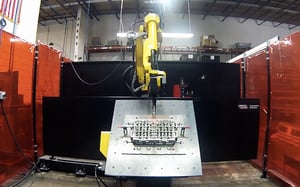 Inconel is the brand name for a family of metal alloys with a high nickel-chromium content that are renowned for their extreme heat tolerance. Inconel alloys retain a high degree of their tensile strength, even at temperatures that melt or burn many other metals. Welding is the process of joining separate pieces of metal—often by heating them to the melting point so they can fuse.
Inconel is the brand name for a family of metal alloys with a high nickel-chromium content that are renowned for their extreme heat tolerance. Inconel alloys retain a high degree of their tensile strength, even at temperatures that melt or burn many other metals. Welding is the process of joining separate pieces of metal—often by heating them to the melting point so they can fuse.
However, given Inconel’s famous temperature resistance, one might assume that welding Inconel is impossible (or at least very difficult). While Inconel welding is tough work, it is doable. It’s important to make Inconel welds the correct way, though—or else they may crack and ruin the workpieces being joined.
How can welding Inconel be done the right way? Following a few basic best practices helps:
Tip #1: Use Tungsten Inert Gas (TIG) for Inconel Welding
Because of the extremely high melting point of most Inconel alloys, directly joining two Inconel workpieces (especially larger ones) is often impractical. Instead, using a welding process that combines high temperatures with a filler material is often the best way to weld Inconel alloys.
Most experienced welders recommend the TIG welding process with a filler material added. While this electrical arc welding process doesn’t typically require the use of a filler material, it’s recommended for Inconel welding because of how hard it is to fuse two pieces of the alloy without cracking them.
Tip #2: Use Inconel 625 for Your Filler Material
Here’s a tip directly from Topwelders.com: “For getting the best results from Inconel alloys, you must use Inconel 625 filler metal. This [filler] metal is one the easiest Inconel alloys for welding.”
Why use Inconel 625 instead of a different, even easier to melt, metal? Because, using a metal that is too dissimilar from the metals being joined can cause problems such as bimetallic corrosion or thermal expansion differentials when exposed to high temperatures. After all, it won’t do you much good to get a “heatproof” Inconel basket if the welds joining its pieces fall apart during your heat treat process.
So, an Inconel welding wire made of the 625 alloy is usually your best choice for Inconel welding filler material.
Tip #3: Use an Automated Machine for Welding Inconel
Completing welds manually by hand is, at best, an inconsistent process. The first few welds might be sloppy as the welder gets into the groove, while the next few are the best, and the rest of the welds suffer because of the welder’s fatigue as he/she repeats the same motions over and over. Combine this with the fact that a person is holding a very hot welding device that’s partially melting a super heat-resistant metal, and you have a recipe for disaster.
Using an automated welding machine for welding Inconel is the best choice because:
- It Increases Safety. Rather than having a worker holding the Inconel welding rod and arc welder, they can simply program a robot to do the dangerous work while he/she supervises. This puts the employee out of harm’s, like burns from dripping Inconel welding filler or sparks.
- It Increases Consistency. Robots don’t need to “get into the groove,” nor do they get tired or suffer repetitive motion stress injuries. Instead, robots can repeat the same exact motions consistently for hours on end without breaks.
- It Increases Quality. Devices such as Marlin’s medium-frequency direct current (MFDC) welding machine help to improve quality by making sure every weld is completed with great precision. The speed of the MFDC welder helps to eliminate weld burns and distortions, keeping welded Inconel parts within their production tolerances.
This is part of the reason why Marlin Steel has invested in factory automation tools and employee training that makes the most of these investments.
Do you need a custom Inconel basket as soon as possible? Reach out to the team at Marlin Steel to get started on your custom basket order!


.gif)


